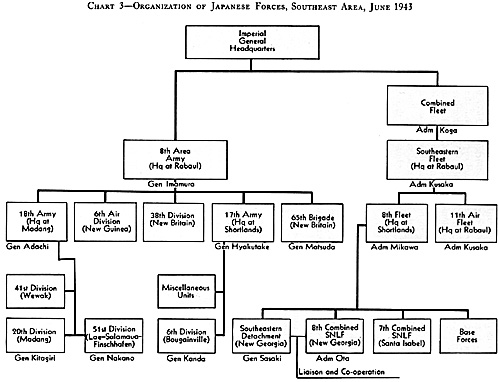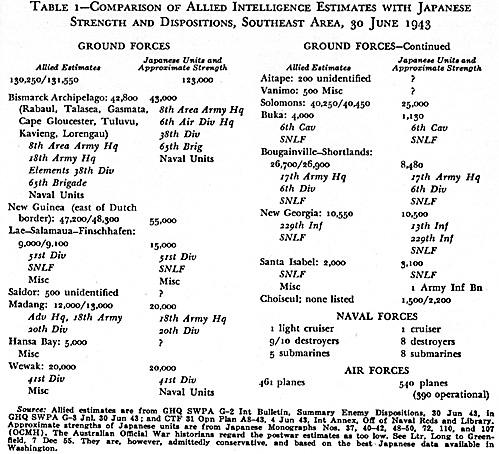
In June Japanese strategy was still substantially what it had been in January. (The basic research for this section was performed by Messrs. Stanley L. Falk and Burke C. Peterson.)
Late in March Lt. Gen. Rimpei Kato, the 8th Area Army's chief of staff, and other officers had gone to Imperial Headquarters, apparently to explain things after the Bismarck Sea debacle. The result of the visit was an Army-Navy "Central Agreement" which was really a reaffirmation of the policies laid down earlier. The Japanese still planned to defend the Solomons while strengthening the bases in New Guinea and the Bismarck Archipelago in preparation for future offensives, especially against Port Moresby. Ambitious plans for air supremacy were prepared, including one for maintaining 641 planes (284 Army and 357 Navy) in the Southeast Area, but, as has been shown above, these were destined to fail.
In April Imamura summoned his army commanders to Rabaul and gave them orders based on the Central Agreement. Instructions to Adachi emphasized holding Lae and Salamaua, building the Madang-Lae highway, and establ Ishing coastal barge lines from western New Britain to Lae and Salamaua. In fulfillment of the policy of using naval air in the Solomons and Army air in New Guinea, the entire 6th Air Division was told to move to New Guinea.
In June Imamura issued more orders, which restated the importance of Lae and Salamaua. The 18th Army was told to strengthen them as well as Wewak, Madang, and Finschhafen. Adachi was to regroup his forces at Lae and Salamaua and prepare to capture the Allied outposts and patrol bases at Wau, Berta Bena, and Mount Hagen, and to infiltrate up the Ramu and Sepik River Valleys.
In anticipation of the operations against Bena Bena and Hagen, Imperial Headquarters transferred the 7th Air Division from the Netherlands Indies to the 8th Area Army about July, and shortly afterward placed Headquarters, 4th Air Army under Imamura to coordinate operations of the two air divisions.
Imamura also developed an ambitious airfield construction program which involved building new fields or enlarging old ones. By June, too, all divisions of the 18th Army--the 20th, 41st, and 51st were concentrated in New Guinea. The 17th Army, still consisting chiefly of the 6th Division, was in Bougainville. The Southeastern Detachment and the 8th Combined Special Naval Landing Force were dug in deeply in New Georgia, and the 7th Combined Special Naval Landing Force and Army elements still held Rekata Bay at Santa Isabel.
It is not possible, on the basis of existing information, to state positively just how many troops Imamura had under his command at this time. These figures, and those in the table of strength and dispositions, are guesses based on available enemy data: for the Solomons, 25,000; for the New Guinea coast east of the Dutch border, 55,000; for the Bismarck Archipelago, perhaps 43,000 ground troops, for a total of 123,000.
( Strength tables and reports do not seem to have survived the war, and available wartime and postwar documents and accounts are inexact, contradictory, or both. The most detailed figures on Japanese Army strength in the Southeast Area for June 1943 are contained in Southeast Area Naval Operations, Vol. II, Japanese Monograph No. 49 (OCMH), pp. 22-23, but this account gives no hint of the source of the figures that are not supported by the few strength figures in Army records. For example, the naval account states that there were 55,000 men holding Lae, Salamaua, Finschhafen, Madang, and Wewak--the 18th Army's area of responsibility--in June 1943, but an 18th Army statistical table indicates that the 18th Army then contained 80,000 men. The office of Official War History, Department of the Interior, of the Commonwealth of Australia, believes that the figure of 80,000 for the 18th Army is correct. Ltr, Mr. Gavin Long to Dr. Kent Roberts Greenfield (Chief Historian, OCMH), 7 Dec 55, OCMH. Japanese documents give no data on ground-troop strength in the Bismarck Archipelago for June 1943. The nearest date for which there are anything like valid figures is November 1943, and those figures are given in the U.S. Strategic Bombing Survey's The Allied Campaign Against Rabaul. Its text asserts that in November 1943 there were 97,870 (76,300 Army and the remainder Navy) in the Bismarck Archipelago, but this statement does not seem to be solidly supported by the interrogations upon which the text is based. General Imamura is quoted on pages 10, 11, and 82, as stating that of 80,000 troops in the Rabaul area in November, 55,000 belonged to his army. From whatever November figure is selected, the strength of the 17th Division, which arrived in New Britain in September and October of 1943, must be subtracted. Unfortunately, there are no figures on that division's strength. The figure 43,000, given in the text above, for the Bismarcks was obtained by the arbitrary method of subtracting 12,000, a reasonable estimate of the strength of the 17th Division, from Imamura's November figure Of 55,000. There are fewer problems for the Solomons, which seem to have contained about 25,000 Japanese ground troops.)
In aircraft, the Japanese possessed a total of something over 500 planes in June, though some of them were usually out of action. For example, of the 300 planes assigned to the 11th Air Fleet on 3o June, only 225 were ready for combat operations. Of 240 belonging to the 6th Air Division, 50 needed minor attention and 25 required major repairs.
Planes were given a high degree of tactical mobility by the large number of conveniently spaced air bases in the area. Kavieng had one field. Rabaul boasted four--Lakunai, Vunakanau, Rapopo, and Keravat (which never amounted to much) with one more under construction at nearby Tobera. In addition, the 8th Area Army was improving fields, or building new ones, at Wewak, Hansa Bay, Alexishafen, Madang, Lae-Salamaua, Tuluvu, and Talasea. The same situation prevailed in the Solomons. Besides the New Georgia fields and the seaplane bases at Rekata Bay and Shortland-Faisi, there were fields at Kahili and Ballale in the Buin-Shortlands area, and another, Kara, soon to be built. There was one at Buka, with another, Bonis, under construction just across Buka Passage. On the east coast of Bougainville the Tenekau and Kieta strips were being built, apparently under orders of the 8th Area Army. (In addition to the Japanese monographs cited above, see USSBS, The Allied Campaign Against Rabaul, pp. 11-12, 46; USAFISPA Photo Int Unit Periodic Rpt, Airdromes and Seaplane Anchorages, Jul 43.)
The 8th Fleet, in June, had one cruiser, eight destroyers, and eight submarines. The potential of this fleet had been cut somewhat by Admiral Mineichi Koga, who had succeeded to command of the Combined Fleet. Because the recapture of Attu in May was regarded as a direct threat to the Japanese homeland, he diverted 20 percent of the forces (apparently including aircraft) "in the course of being assigned or available for assignment" in the Southeast Area to the Aleutians and to Saipan. (Southeast Area Naval Operations, II, Japanese Monogr NO. 49 (OCMH), 18.)
Table I compares Allied estimates of enemy strength, and dispositions of that strength, with an approximation of enemy strength and dispositions based on available enemy records. It will be noted that Allied estimates for Japanese strength and dispositions throughout the Southeast Area were quite accurate.
In June 1943 the Japanese still cherished ambitions toward future offensives. It is clear in retrospect that their resources made them capable of defensive action only. But, as at Guadalcanal and Buna, the Japanese were so skillful in defensive operations that Allied troops were faced with a long series of hard battles.

More The Japanese
- Command and Strategy
Japanese Offensives: January-June 1943
The I Operation: March-April 1943
Japanese Strength and Dispositions: June 30, 1943
Back to Table of Contents -- Operation Cartwheel
Back to World War Two: US Army List of Issues
Back to MagWeb Magazine List
© Copyright 2002 by Coalition Web, Inc.
This article appears in MagWeb (Magazine Web) on the Internet World Wide Web.
Other military history articles and gaming articles are available at http://www.magweb.com